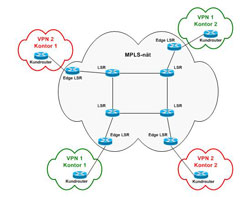MPLS networks are frequently mentioned as a way to connect multiple business locations. But what exactly is MPLS, and why is it superior to other network architectures?
 MPLS, or Multi-Protocol Label Switching, is a technology distinct from traditional circuit-switched or packet-switched networks. While it allows IP traffic transmission, it doesn’t rely on IP routing.
MPLS, or Multi-Protocol Label Switching, is a technology distinct from traditional circuit-switched or packet-switched networks. While it allows IP traffic transmission, it doesn’t rely on IP routing.
The advantage of MPLS networks lies in their ability to handle almost any protocol without requiring conversions to fit the network structure. They also provide high security due to their unique technology and private nature, accessible only by authorized users. Built-in quality of service makes MPLS suitable for enterprise VoIP and other latency-sensitive applications.
Here’s a simplified explanation of MPLS: You connect to the network “cloud” using a label edge router (LER). As the entry point, this LER acts as an ingress router, encapsulating your packets by adding an MPLS label. This label defines a forwarding equivalence class (FEC) that dictates the packet’s path. As packets move through the network, Label switching routers (LSR) only consider the label, not the packet’s contents, for routing decisions. At the destination, an egress LER removes the labels, and the packet exits the network in its original form.
The use of labels makes MPLS both unique and inherently more secure than public networks like the internet. A potential eavesdropper wouldn’t understand the labels used on a particular network, rendering the data meaningless. Accessing MPLS network data is improbable in the first place, as it doesn’t traverse public networks. This is why MPLS networks are also known as MPLS VPNs. For additional security, encryption can be applied to packets transmitted over an MPLS VPN.
MPLS networks ensure quality of service through label technology and meticulous network engineering. The labels contain a 3-bit traffic class field indicating quality of service, priority, and explicit congestion notification. The network provider is responsible for ensuring sufficient bandwidth for all users. MPLS networks are designed for mesh networking but can also be configured as point-to-point connections between two locations.
With the shift towards Carrier Ethernet, MPLS networks have become a natural fit for connecting numerous sites nationally or internationally. Each site requires an access connection, which can be Ethernet over Copper or Ethernet over Fiber, based on bandwidth needs. The MPLS network transmits the Ethernet packets without alteration, creating an end-to-end Ethernet network without the burden of managing a long-haul network. MPLS’s transparency even allows for layer 2 switched connections.
Economies of scale make MPLS networks cost-effective for interstate or international connections. Users get the expected quality of service of dedicated lines combined with the flexibility of a “cloud” that can easily adapt to additional site connections or increased bandwidth demands.
Is MPLS the right solution for your business? If you need to connect multiple locations, regardless of protocol or application, consider obtaining MPLS network services pricing tailored to your requirements.
Note: MPLS network diagram courtesy of Wikimedia Commons.

